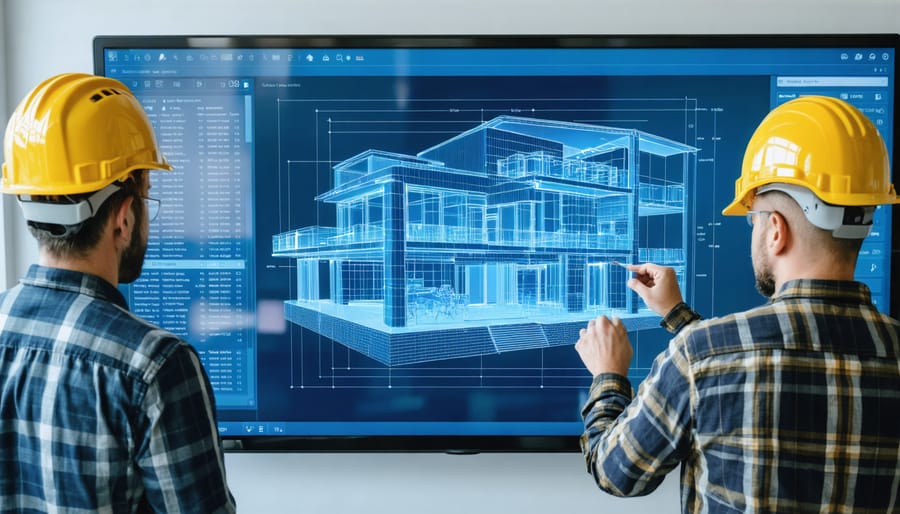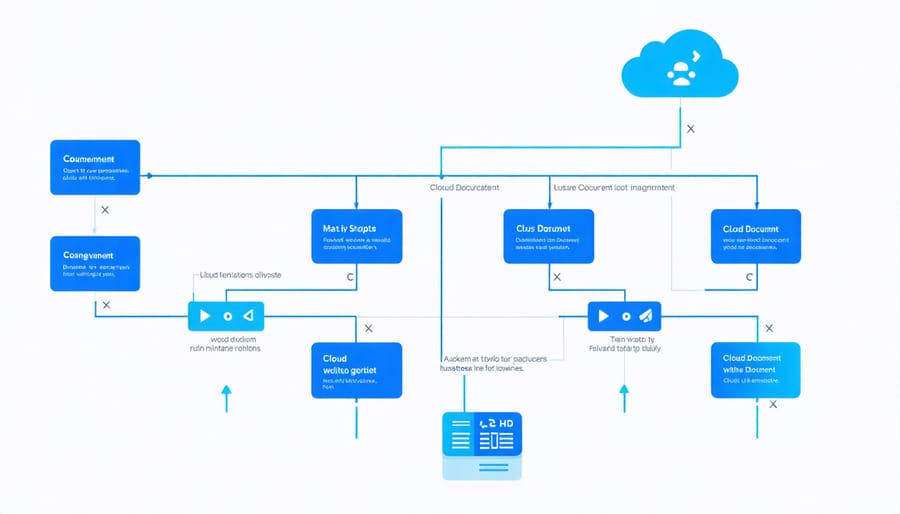Digital construction tools are revolutionizing project delivery across the architecture, engineering, and construction (AEC) industry, driving unprecedented improvements in efficiency, accuracy, and collaboration. From Building Information Modeling (BIM) platforms that enable real-time 3D visualization to cloud-based project management solutions that streamline workflows, these technologies are transforming traditional construction processes into data-driven operations. Industry leaders leveraging these digital tools report up to 40% reduction in project delays and a 35% decrease in documentation errors.
The integration of mobile applications, IoT sensors, and artificial intelligence has created a connected construction ecosystem where stakeholders can make informed decisions based on real-time data. Project managers now monitor site progress through drone surveys, verify installation quality using augmented reality, and track resource utilization through automated systems. This digital transformation isn’t just about adopting new technology—it’s about fundamentally changing how construction projects are planned, executed, and delivered.
As construction complexity increases and margins tighten, these digital tools have become essential for maintaining competitiveness in the modern construction landscape. Understanding and implementing these solutions effectively can mean the difference between project success and costly overruns.
Building Information Modeling (BIM) Integration

Real-time Collaboration Features
Real-time collaboration platforms have revolutionized how construction teams coordinate and communicate across projects. Modern Building Information Modeling (BIM) solutions enable multiple stakeholders to work simultaneously on the same model, dramatically reducing coordination errors and improving project efficiency. These platforms integrate seamlessly with BIM integration with AI, creating powerful ecosystems for project delivery.
Cloud-based collaboration tools allow architects, engineers, and contractors to access current project information from any location, facilitating immediate decision-making and problem-solving. Version control systems maintain a clear record of changes, while clash detection features automatically identify potential conflicts between different building systems before they become costly site issues.
Recent studies indicate that teams using collaborative BIM platforms experience up to 50% reduction in RFIs (Requests for Information) and achieve 25% faster project delivery times. These platforms excel in managing complex workflows, with features like real-time markup tools, automated notifications, and integrated communication channels.
Leading solutions now offer mobile compatibility, enabling on-site teams to access and update project information instantly. This connectivity ensures that field personnel always work with the latest design iterations and can quickly communicate site conditions back to the office team, maintaining project momentum and reducing costly delays.
Cost Estimation and Material Planning
Building Information Modeling (BIM) has revolutionized cost estimation and material planning in construction projects, offering unprecedented accuracy and efficiency in budget management. Through detailed 3D modeling and integrated cost management software solutions, project managers can now generate precise quantity takeoffs and cost estimates automatically, reducing human error and saving valuable time.
BIM’s capability to perform real-time cost analysis enables teams to make informed decisions during the design phase, preventing costly modifications during construction. The technology’s 5D capabilities integrate time and cost dimensions with 3D models, allowing stakeholders to visualize project expenses across different construction phases and scenarios.
Material planning benefits significantly from BIM’s detailed component libraries and scheduling features. Project managers can accurately forecast material requirements, optimize procurement timing, and reduce waste through better resource allocation. The system’s clash detection capabilities help identify potential conflicts before they occur on-site, preventing material waste and unexpected costs.
Recent industry data shows that projects utilizing BIM for cost estimation and material planning typically achieve 15-20% better budget accuracy and reduce material waste by up to 30%. This improved efficiency stems from BIM’s ability to provide detailed quantity surveys, precise material specifications, and automated updates when design changes occur.
Mobile Project Management Solutions

Field Data Collection Apps
Field data collection apps have revolutionized how construction teams gather, document, and share site information in real-time. These mobile applications enable workers to capture photos, record observations, complete inspection forms, and submit reports directly from the field, eliminating paper-based processes and reducing documentation errors.
Leading solutions like PlanGrid, Fieldwire, and Raken offer comprehensive features including digital punch lists, safety checklists, daily reports, and issue tracking capabilities. These apps typically integrate with cloud storage systems, allowing instant synchronization of collected data across devices and immediate access for office-based team members.
Key benefits include standardized data collection processes, improved communication between field and office personnel, and enhanced project documentation quality. Most applications support offline functionality, enabling teams to continue working in areas with limited connectivity and automatically syncing data when reconnected.
Construction companies report significant time savings, with field personnel spending up to 50% less time on administrative tasks. The automated documentation also provides valuable project insights and helps maintain detailed records for compliance and quality assurance purposes.
When selecting a field data collection app, organizations should consider factors such as user interface simplicity, integration capabilities with existing systems, and customization options for company-specific workflows.
Quality Control and Safety Inspection Tools
Modern construction sites are increasingly adopting digital quality control and safety inspection tools to ensure compliance with industry standards while enhancing workplace safety. Advanced mobile applications and cloud-based platforms enable real-time documentation of safety observations, defect tracking, and compliance monitoring.
Digital checklist applications streamline inspection processes by providing standardized templates that can be customized to project-specific requirements. These tools allow inspectors to capture photos, add annotations, and generate comprehensive reports directly from the field. Integration with project management software ensures immediate notification of safety concerns to relevant stakeholders.
Wearable technology and IoT sensors play a crucial role in monitoring environmental conditions and worker safety. Smart helmets equipped with sensors can detect falls, measure ambient temperature, and monitor air quality, while connected devices track equipment usage patterns to prevent accidents and maintain compliance with safety protocols.
Drone technology has revolutionized site inspections by providing access to hard-to-reach areas and creating detailed visual documentation of safety conditions. Advanced imaging capabilities, combined with AI-powered analysis, help identify potential hazards before they become critical issues.
Quality management platforms facilitate automated tracking of material certifications, safety documentation, and regulatory compliance, creating a comprehensive digital trail that supports audit requirements and risk management strategies.

Cloud-Based Document Management
Version Control and Document Tracking
Version control and document tracking systems have become essential components of modern construction project management, enabling teams to maintain precise control over document revisions and approval workflows. These digital tools ensure that all stakeholders work with the most current versions of plans, specifications, and project documents while maintaining a comprehensive audit trail of changes.
Leading construction management platforms incorporate automated version control features that track modifications to drawings, specifications, and project documentation. Each revision is timestamped and attributed to specific team members, eliminating confusion about document status and accountability. These systems typically include check-in/check-out functionality to prevent concurrent editing conflicts and maintain document integrity.
Document approval workflows can be customized to match organizational hierarchies and project requirements, with automated notifications keeping stakeholders informed of pending reviews and approvals. Digital signatures and approval stamps provide secure verification of document status, while detailed logging capabilities satisfy compliance requirements and facilitate project audits.
Cloud-based version control systems also enable real-time collaboration while maintaining document security. Team members can access the latest versions from any location, with permission-based access ensuring that sensitive information remains protected.
Digital Workflow Automation
Digital workflow automation has revolutionized document management in construction projects, streamlining traditionally paper-heavy processes into efficient digital workflows. Modern construction management platforms now integrate document control systems that automatically route submittals, RFIs, and change orders through predefined approval chains, significantly reducing processing time and human error.
These automated systems maintain a clear audit trail of all document activities, ensuring compliance and accountability throughout the project lifecycle. Key features include automated version control, intelligent document routing based on project roles, and integrated notification systems that alert stakeholders when action is required.
Construction firms implementing workflow automation report up to 60% reduction in document processing time and a 40% decrease in administrative overhead. The technology enables real-time collaboration between field teams and office staff, with automatic synchronization across devices and locations.
Advanced systems also incorporate machine learning capabilities to recognize patterns in document flows, suggesting optimization opportunities and flagging potential bottlenecks before they impact project timelines. Integration with mobile applications allows for immediate document access and approval processes from any location, essential for today’s distributed workforce.
ROI Analysis and Implementation Strategies
Implementing digital project management tools requires careful consideration of both financial implications and organizational readiness. Our analysis of successful implementations across multiple construction firms reveals that ROI typically manifests in three key areas: reduced project delays (15-25% improvement), decreased rework costs (20-30% reduction), and enhanced resource utilization (25-35% efficiency gain).
To maximize return on investment, organizations should follow a structured implementation approach:
1. Assessment Phase (2-4 weeks):
– Evaluate current workflows and pain points
– Document existing processes and inefficiencies
– Calculate potential cost savings and productivity gains
– Define specific KPIs for measuring success
2. Tool Selection (4-6 weeks):
– Create a comprehensive requirements checklist
– Evaluate vendor offerings against organizational needs
– Consider integration capabilities with existing systems
– Assess total cost of ownership, including training and maintenance
3. Pilot Implementation (8-12 weeks):
– Select a specific project or team for initial deployment
– Establish baseline metrics for comparison
– Provide intensive training and support
– Document challenges and solutions
4. Full-Scale Deployment (3-6 months):
– Develop a phased rollout strategy
– Create standardized training programs
– Establish support systems and procedures
– Monitor adoption rates and address resistance
Key success factors include:
– Executive sponsorship and visible leadership support
– Dedicated implementation team with clear responsibilities
– Comprehensive training program for all user levels
– Regular performance monitoring and feedback loops
– Clear communication channels for user support
Construction firms should expect a learning curve of 3-6 months before reaching optimal efficiency. Initial investment typically ranges from $500-$2000 per user, with ROI breakeven occurring within 12-18 months for most organizations implementing comprehensive digital solutions.
As the construction industry continues to evolve, digital construction tools have become indispensable for achieving higher efficiency, accuracy, and project success. These technologies have demonstrated their value through improved collaboration, reduced errors, enhanced safety, and significant cost savings across projects of all sizes.
The integration of BIM, mobile applications, drone technology, and project management software has revolutionized traditional construction processes. Companies that have embraced these digital solutions report up to 25% reduction in project delays and a 20% increase in overall productivity. The data-driven insights provided by these tools enable better decision-making and risk management throughout the project lifecycle.
Looking ahead, emerging trends suggest even greater advancement in digital construction technology. Artificial intelligence and machine learning will further optimize project planning and resource allocation. The rise of digital twins and augmented reality promises to transform site visualization and maintenance operations. Additionally, the increasing focus on sustainability will drive the development of tools specifically designed for green building practices and energy efficiency analysis.
For construction professionals, staying current with these digital tools is no longer optional but essential for maintaining competitiveness. As technology continues to advance, we can expect to see more seamless integration between different digital platforms, improved real-time collaboration capabilities, and enhanced mobile functionality. The future of construction is decidedly digital, and organizations that adapt quickly will be best positioned for success in this evolving landscape.

